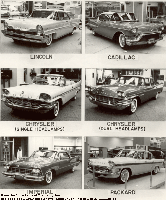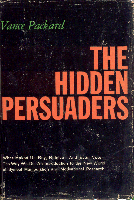
A History of Scholarship on American Automobile Design
Emergence of a Critical Popular Literature
In the late 1950s, however, there was a change in the tone of the popular literature on auto styling. Critical voices began to appear in this field that had previously been almost uniformly laudatory. The 1950s was, of course, the heyday of American automobile styling. In postwar America there emerged a broadly shared, mass prosperity that brought millions of working-class consumers into the market for new cars. In order to differentiate their cars from the competition and stimulate product turnover in the market, automakers turned to the stylists, who superficially changed the aesthetics of cars every year and consistently made all cars bigger, more powerful, and more glitzy. The heightened competition among stylists for newness and distinction drove auto design to dizzying heights of frivolity and absurdity. Functionless tail fins soared to the heavens, and chrome decoration spread like a cancer. By 1957, however, Americans were beginning to question such automotive extravagance. The first postwar recession in America took the wind out of the sails of consumer exuberance, as did the Soviets beating the U.S. into space with the launch of the Sputnik satellite. These events made Detroit’s chromed-up, befinned dinosaurs look rather wasteful.
Reflecting this critical mood of the public
were two best-selling books, Vance Packard’s The
Hidden Persuaders (1957) and John Keats’s The
Insolent Chariots (1958). Both books condemned auto stylists for appealing to consumers’ deeply buried emotional needs, rather than their rational needs for efficiency and safety. Packard’s book argued that auto design was part of a larger attempt on the part of advertisers and merchandisers to manipulate and control consumers by discovering their repressed needs through psychological testing and then incorporating them into advertising and product design. In his book focused exclusively on autos, Keats agreed, arguing that cars were designed and marketed to appeal to the emotional needs of “daydreaming nitwits.” Both focused on sex as one of the most important “hidden persuaders” designed into autos. Keats claimed that stylists consciously and deliberately designed into cars sexual symbols, like penile
hood ornaments, bosom-like
bumper bullets, and vaginal
grilles.
As the 1950s moved into the 1960s, American consumers became aware of not merely
the psychological traps but also the physical dangers of style-driven dream
machines, thanks to one of the most scathing criticisms of American automobiles
of all times, Ralph Nader’s Unsafe
at Any Speed (1965). Consumer questions about auto safety were already being raised when Nader
published his bombshell of a book while working as an advisor to Senate hearings
on the issue. But the book focused and intensified concerns. He devoted an
entire chapter to the stylists, whom he charged with catering to the consumer’s emotional wants for status, glamor, and freedom instead of their rational needs for safety and efficiency. Thus, for example, the stylists created the hardtop to capture the convertible’s feel of freedom and sportiness. But the hardtop’s appeal to these emotions required removal of the center door pillar, which allowed the roof to collapse in rollover accidents. The “repetitive, emotional exploitation” of consumers by stylists, Nader argued, ultimately endangered their lives by preventing engineers from designing safe cars.
These critical books certainly seemed to resonate with the mood of American consumers, who were feeling a bit guilty about their frivolous products and feared that somehow they were being manipulated behind their backs. But the factual content of these popular criticisms of auto styling left a lot to be desired. The authors were correct in stating that merchandisers of this era were researching the emotional appeal of automobiles, but wrong in arguing that this research determined auto design. The automobile stylists were very protective of their autonomy, and fought hard and successfully to eliminate the influence of the marketing staff on design. They believed that they knew consumers better than the marketers with all their surveys, and by the 1950s stylists had almost complete control of auto design. This is not to say, however, that the stylists themselves did not appeal to consumer emotions in their designs. They obviously did, for when they spoke of their designs their comments were laced with words like “excitement,” “freedom,” and “fun.” But their emotional appeals were not conscious and calculated, as Packard, Keats, and Nader argued, but intuitive and unstudied. Car designers in these days worked by visual intuition, relying on a general feeling for what looked exciting and fun drawn from the larger culture. They rarely sought to give any verbal rationale for their designs; on the contrary, there was an informal prohibition against such talk in the industry, captured in the common rebuke among stylists, “I can see, but I cannot hear.”
What about the charge of explicit sexual symbolism? In the ultra-macho subculture of auto designers, sex was surely an important appeal. But again, it was not expressed as simplistically and directly as the critics charged, that is, through anatomical analogies. Sexiness was appealed to intuitively and indirectly, such as associating cars with leisure and vacation, generally the arena of life to which sexual activity was confined. Probably the biggest problem with these quasi-Freudian psychological analyses of design was that they were unable to account for constant change in auto aesthetics. If cars were designed to appeal to some universal but unconscious desires and drives, why were stylists always changing them? Such desires and needs may exist, but they are always channeled through changing social institutions, which may deny, realize, or sublimate them. For example, to understand why tail fins connoted excitement and freedom to Americans in the 1950s, we have to examine the role that military aviation played in World War II and the immediate postwar period. The simplistic psychological analyses ignored the social context of automotive symbolism.
<<Previous Section - Next Section>>
©2004 Automobile in American Life and Society








